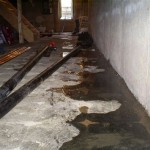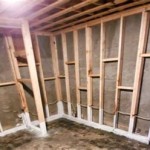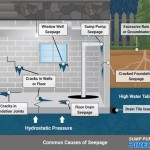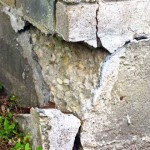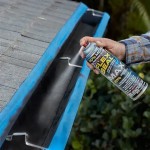What To Do When Your Basement Starts Flooding In Taiwan
Taiwan, renowned for its vibrant culture and technological prowess, is also susceptible to natural disasters, particularly typhoons and heavy rainfall, especially during the typhoon season (typically May to October). These weather events can overwhelm drainage systems and lead to localized flooding, often affecting basements in residential and commercial properties. When a basement begins to flood in Taiwan, a swift and methodical response is crucial to mitigate damage, ensure safety, and expedite the restoration process. The following details the necessary steps to take in such a situation.
The initial priority is always personal safety. Flooded basements can pose significant electrical hazards. Before entering the flooded area, it is imperative to disconnect the main power supply to the basement at the circuit breaker or fuse box. This precautionary measure minimizes the risk of electrocution, which is a life-threatening danger in standing water. One should not attempt to touch any electrical appliances or wiring while standing in water. If the location of the breaker box is also flooded or inaccessible, individuals should contact Taiwan Power Company (Taipower) immediately to request a power shut-off to the affected area.
After addressing the immediate safety concerns, the next step involves assessing the source and severity of the flooding. Identifying the cause of the water intrusion is critical for implementing effective solutions. Potential causes include heavy rainfall exceeding the capacity of local drainage systems, sewer backups, burst pipes, or seepage through foundation walls. If the flooding is caused by a burst pipe, the water supply to the affected pipe should be shut off immediately. If the flooding stems from a sewer backup, contacting the local city government or a qualified plumbing professional is essential to address the underlying issue. For flooding caused by rainwater, identifying potential entry points, such as cracks in the foundation or inadequate drainage around the property, is crucial for future preventative measures.
Once the source and severity of the flooding are assessed, the immediate focus should shift to minimizing further damage and removing the accumulated water. This process may involve employing various water removal techniques and equipment. The appropriate method will depend on the volume of water and the resources available. For minor flooding, a wet/dry vacuum cleaner can be used to extract the water. For more substantial flooding, submersible pumps are often necessary to rapidly remove the water. It is recommended to use a pump with an automatic shut-off feature to prevent the pump from running dry and potentially damaging itself. During the water removal process, one should ensure proper ventilation by opening windows and doors to facilitate air circulation and reduce humidity. This will aid in the subsequent drying process and help prevent mold growth.
Ensuring Immediate Safety
The primary concern during a basement flood is the safety of all individuals present. Electrocution is a significant risk, as water is an excellent conductor of electricity. Therefore, the following steps must be taken immediately:
1.
Power Disconnection:
Before entering the flooded basement, locate the main circuit breaker or fuse box that controls power to the basement area. Switch off the corresponding breaker or remove the fuse to cut off the electricity supply. If the breaker box is submerged or inaccessible, contact Taipower immediately to request an emergency power shut-off. Do not attempt to operate any electrical devices or appliances while standing in water.2.
Avoid Contact with Water:
If it is necessary to enter the flooded basement, wear appropriate protective gear, such as waterproof boots or waders. Avoid direct contact with the water, as it may be contaminated with sewage, chemicals, or other hazardous substances. If contact occurs, wash the affected area thoroughly with soap and water.3.
Evacuate if Necessary:
If the flooding is severe or if there are any signs of structural damage, evacuate the building immediately. Contact the local fire department or emergency services for assistance. Do not re-enter the building until it has been deemed safe by qualified professionals.Water Removal and Damage Mitigation
Once the immediate safety hazards have been addressed, the focus should shift to removing the water and mitigating further damage. The following steps are crucial:
1.
Identify the Source:
Determine the cause of the flooding. Is it due to heavy rainfall, a burst pipe, a sewer backup, or seepage? Identifying the source is essential for stopping the inflow of water and preventing future occurrences. If the source is a burst pipe, shut off the water supply to the affected pipe. If the source is a sewer backup, contact a qualified plumber or the local authorities.2.
Remove Standing Water:
Use a wet/dry vacuum cleaner, submersible pump, or other appropriate equipment to remove the standing water as quickly as possible. For large volumes of water, a submersible pump is generally the most efficient option. Ensure that the pump is equipped with an automatic shut-off feature to prevent it from running dry. Direct the discharged water away from the property to prevent it from re-entering the basement.3.
Document the Damage:
Take photographs and videos of the flooded basement and all damaged items. This documentation will be essential for insurance claims and for assessing the extent of the damage. Make a list of all damaged items, including their estimated value.After the water has been removed, the process of drying and dehumidifying the basement must begin promptly. This is essential to prevent mold growth, which can occur within 24 to 48 hours in damp environments. Mold can cause significant health problems and can be difficult and costly to remove. Industrial-grade dehumidifiers and fans should be used to circulate air and remove moisture from the basement. Carpets, rugs, and other porous materials should be removed and dried or discarded, depending on the extent of the damage. Walls and floors should be thoroughly cleaned and disinfected to kill any mold spores. If the mold growth is extensive, professional mold remediation services may be necessary.
It is important to contact one’s insurance company as soon as possible after a basement flood. The insurance company will assess the damage and determine the extent of coverage. Gather all relevant documentation, including photographs, videos, receipts, and a list of damaged items. Cooperate fully with the insurance adjuster and provide all requested information. Understanding one’s insurance policy and its coverage limits is crucial for navigating the claims process effectively. Keep detailed records of all expenses incurred as a result of the flooding, as these may be reimbursable by the insurance company.
Preventative Measures for the Future
Preventing future basement floods requires a multi-faceted approach that addresses potential vulnerabilities and enhances the property's resilience to heavy rainfall and other water-related events. Consider the following measures:
1.
Improve Drainage:
Ensure that the property's drainage system is functioning effectively. Clean gutters and downspouts regularly to prevent clogs. Extend downspouts away from the foundation to direct water away from the building. Grade the surrounding land to slope away from the foundation to facilitate water runoff. Install French drains or other drainage systems to collect and redirect groundwater away from the basement.2.
Seal Foundation Cracks:
Inspect the foundation walls for cracks and seal them with a waterproof sealant. Even small cracks can allow water to seep into the basement. Consider applying a waterproof coating to the exterior foundation walls to provide an additional barrier against water intrusion.3.
Install a Sump Pump:
If the property is prone to flooding or if the water table is high, install a sump pump in the basement. A sump pump automatically removes water that accumulates in a sump pit, preventing it from flooding the basement. Ensure that the sump pump is properly sized for the basement and that it is connected to a reliable power source. Consider installing a backup sump pump or a battery backup system in case of power outages.4.
Backflow Preventer Valves:
Install backflow preventer valves on sewer lines to prevent sewage from backing up into the basement during heavy rainfall. Backflow preventers allow water to flow in one direction only, preventing the reverse flow of sewage into the property.5.
Regular Inspections:
Conduct regular inspections of the basement and surrounding property to identify potential problems before they escalate. Check for signs of water damage, such as dampness, stains, or mold growth. Inspect the drainage system to ensure that it is functioning properly. Address any issues promptly to prevent costly repairs and further damage.Addressing a flooded basement in Taiwan demands a systematic and safety-conscious approach. By prioritizing safety, promptly addressing the water intrusion, and implementing preventative measures, homeowners and property managers can effectively minimize damage, protect their property, and safeguard the well-being of occupants. Contacting qualified professionals, such as plumbers, electricians, and mold remediation specialists, is essential for addressing complex issues and ensuring a thorough restoration process.

What To Do When Your Basement Floods

Excessive Rainfall Causes Of Basement Water Seepage

Sump Pump Failure Dealing With The Aftermath Rytech Restoration

Excessive Rainfall Causes Of Basement Water Seepage

Typhoon Hits After Causing Deaths And Iuries In Taiwan Es Bbc News

Excessive Rainfall Causes Of Basement Water Seepage

Heartbreak In Taiwan Ⅱ Taipei Times

Excessive Rainfall Causes Of Basement Water Seepage

Ontario Flooding What S Covered By Insurance In A Flood

What To Do If Your Hvac System Is Impacted By Flooding
Related Posts
